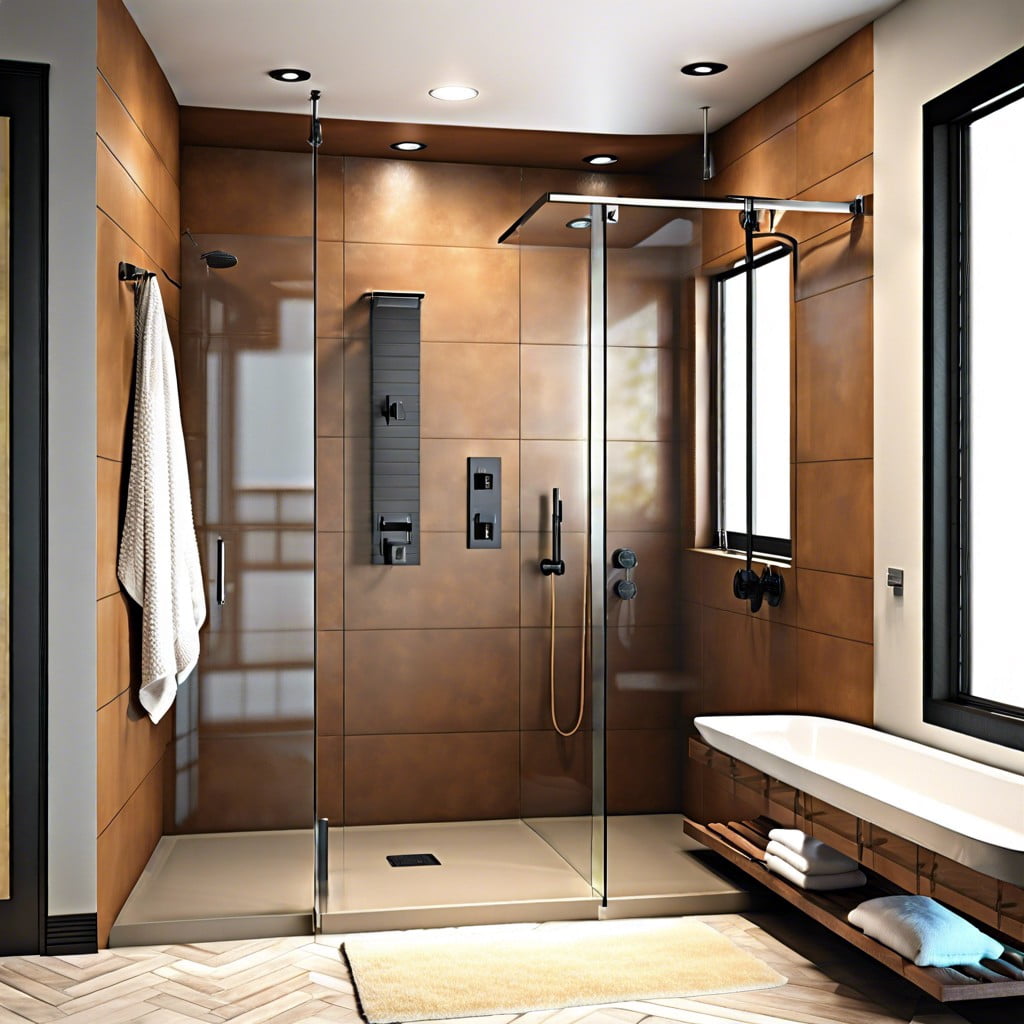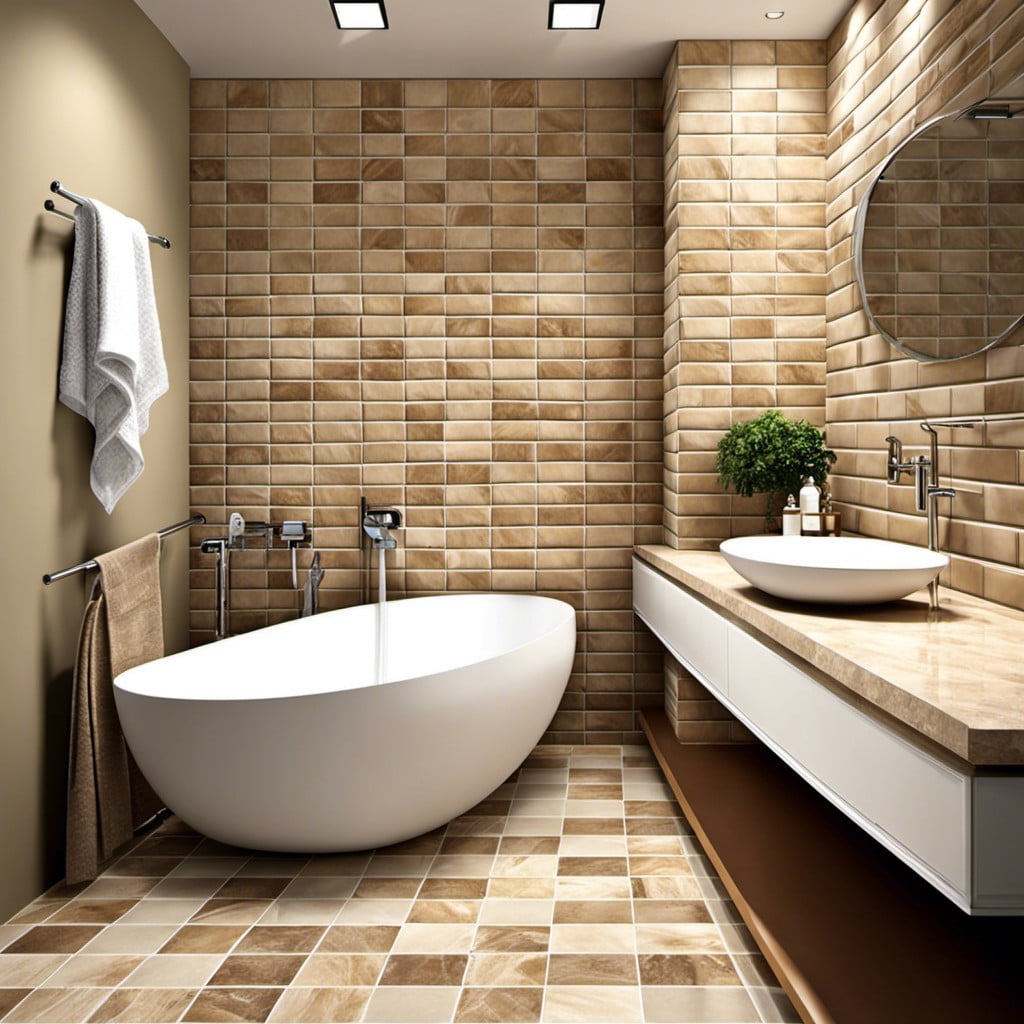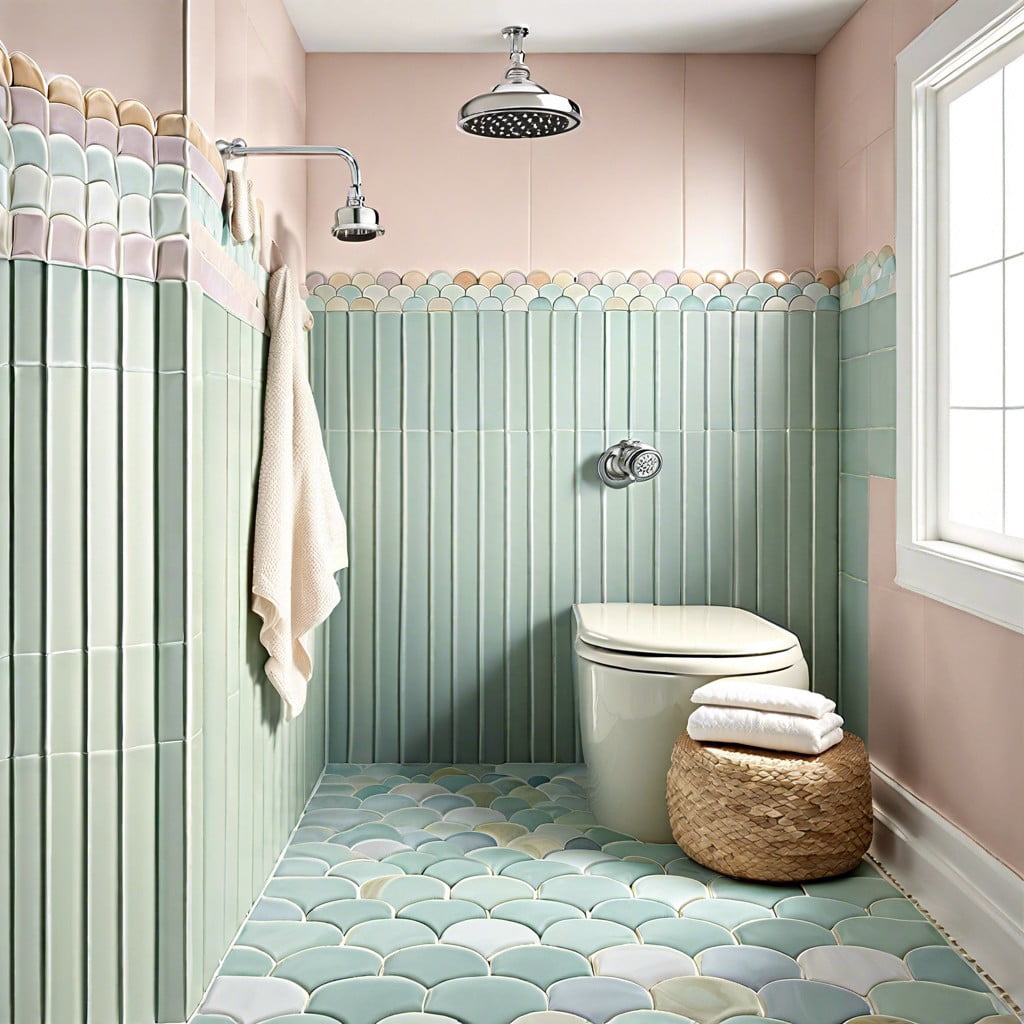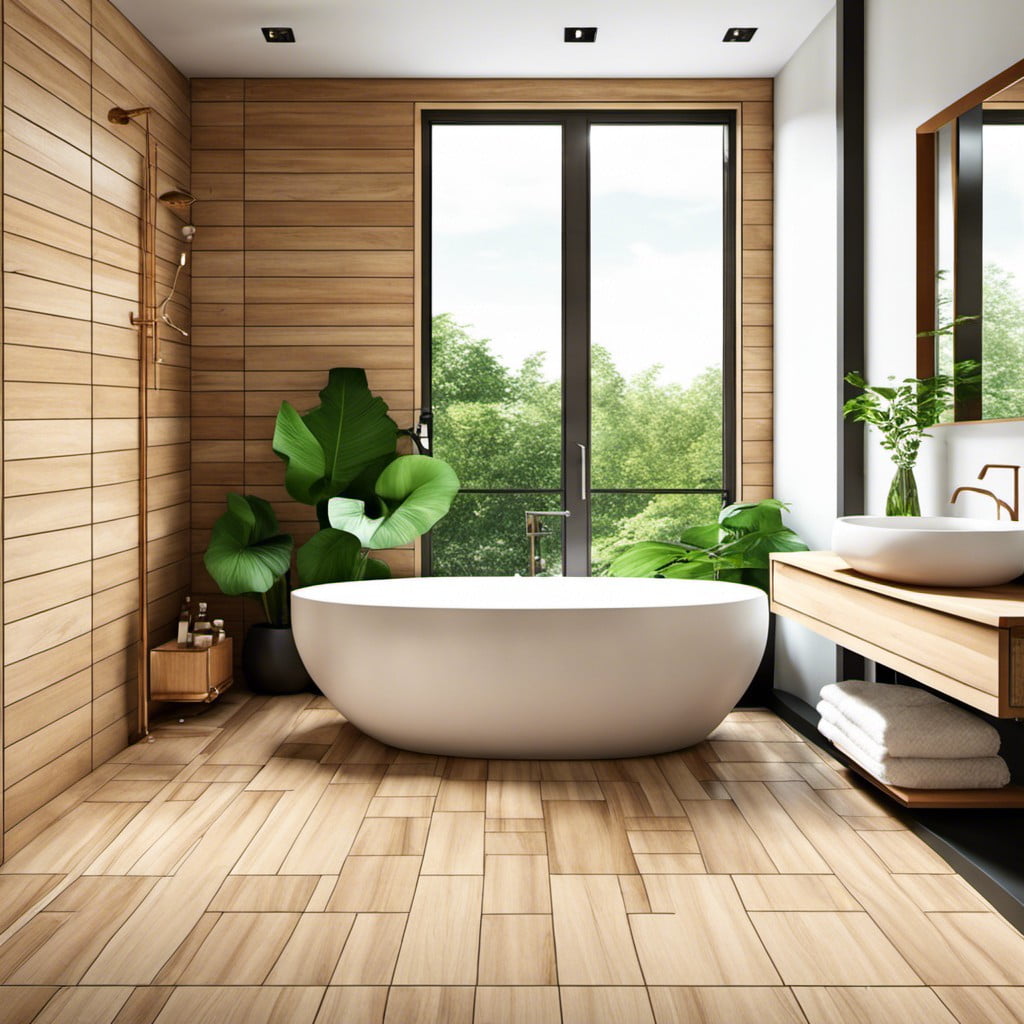Last updated on
Dive into this detailed comparison between porcelain and ceramic tiles and discover which is the prudent choice for your shower walls.
Key takeaways:
- Porcelain is denser, less porous, and more water-resistant.
- Ceramic tiles are easier to cut and install, but more prone to chips.
- Porcelain tiles are more durable and have a longer lifespan.
- Porcelain tiles are harder to cut and require professional installation.
- Porcelain tiles are easier to clean and maintain.
Major Differences
When choosing between porcelain and ceramic tiles for your shower, understanding their dissimilarities is crucial.
Composition is the starting point – porcelain is a denser type of clay, fired at higher temperatures, resulting in a more robust material that’s less porous than its ceramic counterpart.
This inherent property makes porcelain more water-resistant, which is a key factor especially in a shower environment subject to constant moisture.
Furthermore, the color consistency of porcelain goes through its entire thickness, making chips less noticeable.
Ceramic tiles, on the other hand, often have a glazed top layer, with a different color underneath.
This can make chips more obvious, albeit ceramic tiles are typically easier to cut and install, making them a more forgiving choice for DIY projects.
The less porous nature of porcelain enhances its stain resistance but also generally increases the price point, presenting a higher initial investment.
Weight is another factor – porcelain’s density means it’s heavier, which might require more support on shower walls.
By contrasting these key attributes, one can delineate their suitability based on specific needs and conditions of the shower space.
Durability
When considering tiles for shower walls, understanding their resistance to wear is crucial. Ceramic tiles, although quite sturdy, are more prone to chipping and wear over time compared to porcelain. This is because porcelain tiles are fired at higher temperatures, resulting in a denser material that stands up better against daily showers and the occasional accidental knock of a shampoo bottle.
Porcelain’s through-body color—a consistent color all the way through—also gives it an edge. If a chip occurs, it’s less noticeable than on ceramic tiles, which often have a different color underneath the glaze. This small detail can make a significant impact on the longevity of your shower’s appearance.
Yet for all their strength, porcelain tiles can be harder to cut and install. This is something to think about if you’re not a professional. It’s a trade-off: more durable, yet potentially higher installation costs. When deciding, consider the long-term use of the shower and how much traffic it will see. A seldom-used guest bathroom might fare well with ceramic, while your main bathroom might benefit from porcelain’s resilience.
Ceramic Tile
At the heart of many showers, ceramic tiles make for an accessible and colorful choice. They are made from a mix of clays that are then kiln-fired at a lower temperature compared to porcelain. This process results in a softer texture, making them easier to cut and install, which can be particularly appealing for DIY enthusiasts.
Their porous nature requires them to have a glaze applied if they’re to be used in showers where moisture resistance is key. In terms of cost, they often come with a smaller price tag than their porcelain counterparts, easing the budget for your bathroom remodel or construction. Aesthetically, there’s a diverse spectrum of finishes and designs available within the ceramic options, encouraging a custom look that reflects personal style.
However, it’s essential to remember that, while their charm is undisputed, they tend to be less resistant to scratches and wear over time, which could influence their durability in a high-use area like a shower.
Porcelain Tile
Porcelain tiles are forged from finer, denser clay and subjected to higher temperatures, making them the stronger sibling in the tile family. They effortlessly shrug off moisture, which earns them high marks for showers, resisting mold and mildew. Due to their through-body composition, chips or scratches won’t easily betray porcelain’s façade. They sport an impressive breaking strength, so when you mount them on shower walls, rest assured, they’ll stand sentinel against daily showers and the accidental bumps of shampoo bottles.
Available in a myriad of styles and finishes, they mimic the look of natural stone or wood with remarkable authenticity, but without the high maintenance or susceptibility to water damage. However, their Achilles’ heel lies in installation – porcelain is harder to cut and lay, often requiring professional hands. The investment might be higher upfront, but porcelain’s resilience means fewer headaches down the line.
Installation Process
The task of installing tiles in a shower brings its own set of challenges, regardless of whether you’re working with ceramic or porcelain. However, considering the nature of the materials, there are some distinctions that are worth noting.
Ceramic tiles are generally a bit more forgiving for the DIY enthusiast. They’re softer, which translates to easier cuts and less stress on your tile cutter. This can make precise adjustments and fitting less of a headache.
On the flip side, porcelain’s denser structure makes it more formidable against traditional cutting tools. It requires a wet saw with a diamond blade for clean cuts, which might increase the installation time and can be more demanding for those not accustomed to heavier duty equipment.
Both materials require a waterproof membrane behind the tiles to protect your walls from moisture damage. Mastic is recommended for ceramic in dry areas, while thinset mortar is advisable for porcelain or in shower areas directly exposed to water.
For both types, the levelling of the substrate and the layout planning remains crucial. Starting with a level surface ensures that the tiles will sit evenly, reducing the risk of cracked tiles or an uneven finish.
Remember, porcelain’s heavier weight means extra care must be taken to ensure that the adhesive has a strong bond; otherwise, you risk tiles slipping down the wall before they set.
Regardless of your choice, patience and precision are your best tools for a job that leaves a sleek and professional finish.
Maintenance and Cleaning
When it comes to keeping your shower walls pristine, ease of maintenance is a must. Porcelain tiles win in this arena, boasting a less porous surface that resists staining. Spilled shampoo? No problem. A quick wipe down and it’s as good as new.
On the flip side, ceramic tiles can demand more elbow grease due to their higher porosity – a sponge and a bit more effort might be required to tackle those soapy residues.
Both materials, however, shine in the maintenance department when compared to natural stone, requiring no special sealants or treatments. Regular cleaning with gentle, non-abrasive cleaners will keep either looking fresh. For routine upkeep, use a simple vinegar-water solution to effortlessly maintain that gleam without damaging the glaze.
Remember, consistency is key; regular upkeep can prevent mold and mildew buildup, ensuring your shower remains a clean and inviting space.
Longevity
When considering a material that can stand the test of time, porcelain is the heavyweight champion. Its dense composition makes it less prone to wear and tear, allowing it to look pristine for decades, even in the splash zone of your shower.
Ceramic, while durable, doesn’t boast the same longevity and might display signs of age such as cracks or chips sooner.
For those wanting a long-term relationship with their shower walls, porcelain is the tile that promises to stick around, while ceramic might call for a redo down the line to stay fresh.
Appearance
The eyes have it when it comes to finalizing your shower wall choice. Porcelain, having a polished finish, offers a high-end look, replicating natural stone and hardwood patterns with convincing authenticity. Diverse design options mean you can find virtually any color or texture to match your aesthetic dreams, although sometimes at a higher price point.
Ceramic tiles, not to be overshadowed, present a plethora of vibrant colors and patterns, perfect for those seeking to inject personality into their space. Glossy, matte, or hand-painted finishes can create a statement wall or a cozy traditional vibe. It’s worth noting that intricate designs on ceramic tiles can sometimes limit your future decor choices, locking you into a specific style.
In the game of appearance, the winning choice often boils down to the desired look and atmosphere you aim to achieve within your personal haven.
Ceramic Vs. Porcelain Tile: Pros and Cons
Tackling the debate of ceramic vs. porcelain tiles for shower walls, it’s essential to weigh both the advantages and disadvantages. Beginning with ceramic, it’s praised for affordability and a simpler installation process. Its porous nature, while less dense than porcelain, ensures easier cutting and fitting by DIY enthusiasts. However, this porosity can become a pitfall in high-moisture environments, where durability is key, potentially making it less ideal for showers.
Porcelain, on the other hand, boasts a dense body with a low water absorption rate, making it exceptionally suited for the steamy confines of a shower. It’s capable of withstanding heavy usage without succumbing to water damage. Yet, quality comes at a price, with porcelain typically being more expensive and its installation often demanding professional expertise due to its weight and hardness.
In essence, ceramic is friendly for those watching their budgets and who are maybe looking for an easier weekend project. Porcelain emerges as the heavy-duty contender that, while pricier, could provide peace of mind in longevity and performance. The right choice ultimately hinges on balancing these aspects against individual needs and circumstances.
Which Should I Use? Ceramic Vs. Porcelain Tile for Shower Walls and Floors
When choosing between ceramic and porcelain tile for your shower walls and floors, consider the following points to guide your decision:
1. Moisture Exposure: Bathrooms are high-moisture environments. Porcelain’s lower water absorption rate makes it a stalwart against moisture, thus fewer worries about mold and mildew.
2. Budget Constraints: If you’re watching your wallet, ceramic tiles typically come with a lower price tag, offering a balance between cost and functionality.
3. Durability Needs: For floors, especially in family bathrooms with high traffic, the superior durability of porcelain might save you from chips and cracks in the long run.
4. Installation Considerations: Are you a DIY enthusiast or hiring a professional? Ceramic is easier to cut and install, which might endear it to those keen on weekend projects.
5. Design Preferences: Seeking a specific style or a wide range of color and textures? Ceramic offers a broad palette, while porcelain can convincingly mimic natural stone or hardwood.
6. Resale Value: Pondering your home’s future marketability? Porcelain can add a touch of luxury, potentially increasing appeal to prospective buyers.
7. Environmental Conditions: In colder climates, porcelain’s density can withstand temperature swings better, making it a suitable choice not just for indoor showers, but for outdoor installations.
8. Cleaning Habits: Busy lifestyles demand convenience. If you prefer low-maintenance options, porcelain’s through-body composition means it keeps its look even when surface stains occur.
Each of these factors plays a role in steering you toward the tile that will best meet your individual needs, ensuring that your shower remains a welcoming retreat in your home.
FAQ
Which is better for shower walls porcelain or ceramic?
In terms of durability and water resistance, porcelain is a superior choice for shower walls, but factor in cost and ease of installation, ceramic could have its own appeal.
What type of tile is best for shower walls?
In terms of durability and ease of maintenance, porcelain and ceramic tiles emerge as the best options for shower walls.
Can porcelain tile be used on shower walls?
Indeed, porcelain tile can be used on shower walls as it is one of the most suitable surfaces for wet areas.
What are the disadvantages of porcelain tile?
Porcelain tile, despite its exquisite appeal, poses considerable challenges in installation due to its hard-to-cut nature necessitating special tools and the need for a modified setting material for secure anchoring.
How does the durability of porcelain and ceramic tile compare for shower walls?
Porcelain tile, being less porous and more resistant to moisture and stains than ceramic tile, is generally considered more durable for shower walls.
In terms of maintenance, which type of tile, porcelain or ceramic, is easier to clean in a shower setting?
In terms of maintenance, porcelain tile is easier to clean in a shower setting due to its resistance to moisture and stains.
Are there significant cost differences between using porcelain and ceramic tiles for shower walls?
Yes, there are significant cost differences between using porcelain and ceramic tiles for shower walls as generally, porcelain tiles are more expensive than ceramic tiles.
Continue reading:
Recap




